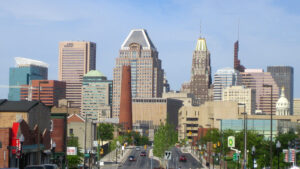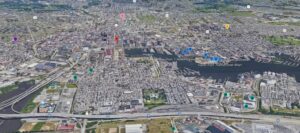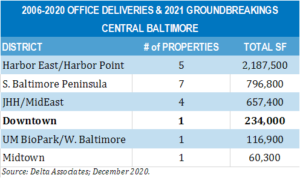Office Construction Migrates from Downtown Baltimore
The location of recent office construction activity in Baltimore City acutely highlights the migration away from Downtown Baltimore. Over 15 years, from 2006 to 2020, only one new office property has delivered in downtown—the 1 Light Street mixed-use apartment/office building. A pre-lease by M&T Bank triggered construction on the 28-story building, but two years since construction completion about a third of the 234,000 SF of office space remains available. The problem for downtown has not been an outright lack of demand, which has been moderate but very consistent over the years, but intense competition from other neighborhoods in the city.
The Harbor East and Harbor Point mixed-use districts have been especially successful at attracting large corporate, blue-chip tenants away from downtown. Most recently T. Rowe Price announced its migration to Harbor Point. In the past Legg Mason and Exelon/Constellation Energy have also moved southeast. Smaller tenants, including tech start-ups and other firms that don’t have as much value for a downtown presence are finding Class A options in southern Baltimore peninsula neighborhoods such as Locust Point, South Baltimore, and the future Port Covington district. Life sciences and R&D firms have long preferred space near the University of Maryland Medical Center and Johns Hopkins University campuses in West and East Baltimore, respectively. Canton is poised to be another major office competitor given plans for multiple office developments to complement the booming residential and retail construction.
Baltimore of course isn’t alone in dealing with increased pressure on its traditional CBD as post-industrial and other formerly neglected neighborhoods in cities across the nation transform into mixed-use live-work-play districts virtually overnight. However, the outmigration in Baltimore’s downtown is especially pronounced as concerns over safety, a lack of a major transit connectivity advantage, and a paucity of retail, residential, and entertainment options hold it back. In the post-pandemic world, competition for a possibly shrinking pool of office tenants will be even more fierce, and the city will have to double down on its efforts to revitalize the downtown core in order to be viable.


